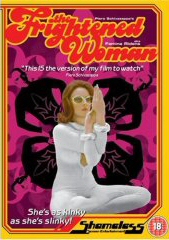
aka The Laughing Woman; aka Femina Ridens. Directed by Piero Schivazappa
It has to be said, I have a bit of a soft spot for sleaze. So it was with a due sense of anticipation that I got my grubby paws on a copy of Schivazappa's The Frightened Woman (1969), released restored and completely uncut by Shameless DVD. I thought I had a reasonable idea of what to expect, but I was surprised by this one: this is no formulaic exploitation film. The Frightened Woman may have a lot of elements in common with other genres but it is quite unique in its approach to its themes of cruelty, power struggles and of course sex.
The film charts the kidnap of an ambitious young journalist, Maria (Dagmar Lassander of House by the Cemetery/ Black Cat fame) by one Doctor Sayer (Philippe Leroy), a warped academic with some very mixed-up ideas about sex. It seems that Sayer has a horror of self-sufficient modern women, particularly when it comes to them controlling their own fertility and sexuality (one of many ways that this film positively screams 1960s!) but he is attracted to them nonetheless, so he does the only thing he can which seems to restore the proper order - makes them his slaves. He torments Maria in a variety of ways, including showing her photographic evidence that he has done all this before and killed a number of women in the throes of his sexual passion. Thus far the relationship between the two people seems as if it is cut-and-dried and that Maria will be next, but - slowly, she begins to unpick Sayer's past, and their relationship becomes more and more complicated. Maria tells the sex-killer that she can rehabilitate him and cure him of his aberrant sexuality, but nothing is ever as it seems: the film spirals into a series of role reversals, twists-in-the-tale and thwarted desires…
Although the film operates in quite a complex fashion, Schivazappa is competent enough to hold the film together very well. Visually, the film is incredibly aesthetics-driven and a real feast: it gives a decadent window into 1960s opulence, with a great array of shots taken in vast, lofty spaces as well as claustrophobically confining ones, and the film doses the viewer with an array of colours, psychedelic patterns and light. As I said above, the film is very much of its period, and its surreal take on gender-politics combined with its psychedelic sets generates an unreal but somehow incredibly authentic-feeling 60s weirdness. It also uses a lot of symbolism and experimental elements, and these nods to art house filmmaking may not be to the tastes of every viewer, especially anyone expecting pure grindhouse-style cinema. That isn't what is on offer here.
The film is a triumph of suggestion over actually showing all that many scenes of sex and violence - and here is another departure from many sleaze/exploitation/giallo genre films, which fans may or may not like. Lots of the implied content works well, but in a few instances the 'sensual' symbolism of some scenes seem a little dubious to my jaded 21st century tastes. Overall that isn't the case though, and The Frightened Woman is a great excursion into subtle strangeness. It certainly kept me guessing throughout, and I'd definitely recommend it to any fans of early Jess Franco's or Massimo Dallamano's cinema.
Shameless are open about the fact that there are some discrepancies in sound and picture quality during the film. I did notice one or two, but as Shameless worked from a variety of sources to put the print together according to director Piero Shivazappa's express orders, they have done a great job here as always. There's certainly nothing to interfere with viewing and it's gratifying to see this film in its entirety.
As far as extras go, Shameless offer an extensive trailers reel including My Dear Killer, What Have You Done to Your Daughters?, Baba Yaga - The Devil Witch, Venus in Furs, Ratman and The Black Cat, all of which have been remastered to a turn, as well as a theatrical trailer for The Frightened Woman and a plug for Shameless's online forum. The film is presented in 16/9 anamorphic widescreen and PAL colour with a running time of 86.03.
Review by Keri O'Shea
| Released by Shameless |
| Region 2 - PAL |
| Rated 18 |
| Extras : |
| see main review |